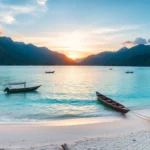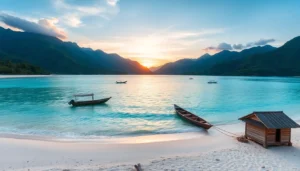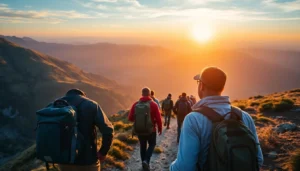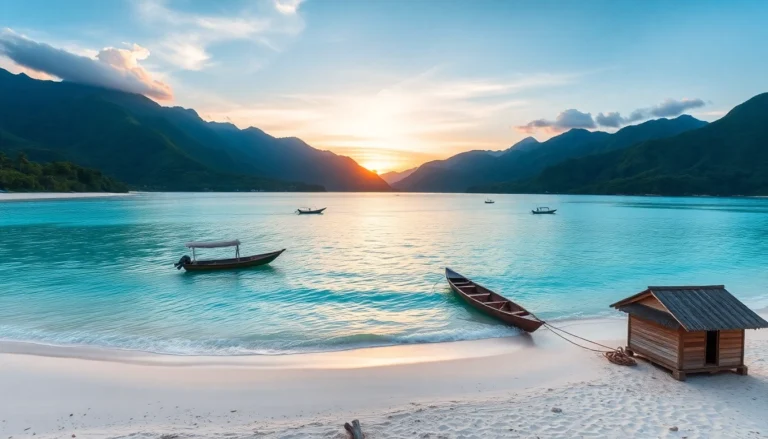Introduction to Trekking and Cycling in Lombok
Discovering the natural beauty and vibrant culture of Lombok, Indonesia, is an adventure best experienced through trekking and cycling. These activities allow travelers to intimately connect with the island’s diverse landscapes, from lush rainforests and rugged mountains to pristine beaches and traditional villages. Whether you’re a seasoned trekker or a casual cyclist, Lombok offers an array of options that cater to all skill levels and interests. Engaging in a Trek through this tropical paradise not only provides physical activity but also immerses you in the authentic local ways of life, making your journey both memorable and meaningful.
In this comprehensive guide, we delve into the world of trekking and cycling in Lombok—exploring the most popular routes, gear essentials, safety tips, cultural highlights, and how to plan a trip tailored your preferences and abilities. As Indonesia’s lesser-known yet equally captivating neighbor to Bali, Lombok is increasingly becoming a hotspot for adventure travel, providing off-the-beaten-path experiences that appeal to eco-conscious explorers and thrill-seekers alike. Let’s get started on creating your perfect Lombok adventure plan.
Understanding the Appeal of Trekking in Indonesia
The Unique Allure of Indonesian Trekking Experiences
Indonesia boasts a rich tapestry of landscapes that make it an unparalleled destination for trekking enthusiasts. From volcanic peaks to ancient rainforests, the country’s diverse topography offers numerous opportunities for exploration. The appeal of trekking in Indonesia lies in its ability to combine adventure with cultural immersion and environmental appreciation. It’s not just about conquering a mountain but experiencing local traditions, diverse flora and fauna, and breathtaking vistas at every turn.
Specifically, in Lombok, the striking presence of Mount Rinjani—the second-highest volcano in Southeast Asia—serves as a magnet for trekkers seeking a challenging and rewarding ascent. The trek to the crater lake, Segara Anak, is renowned for its dramatic scenery, geothermal activity, and cultural landmarks. Beyond mountain expeditions, the island’s coastal and jungle trails highlight Indonesia’s ecological diversity, offering various degrees of difficulty for different travelers.
Furthermore, Indonesia’s focus on sustainable tourism and eco-friendly practices enhances the trekking experience. Many local operators emphasize responsible travel, supporting conservation efforts and promoting cultural sensitivity. As a result, trekking in Indonesia becomes a meaningful journey that benefits both visitors and host communities.
Popular Trekking Routes and Cycling Trails in Lombok
Mount Rinjani: The Crown Jewel of Lombok
The Mount Rinjani trek is the most iconic and challenging adventure in Lombok. Standing at 3,726 meters, it is Indonesia’s second-tallest volcano and attracts trekkers from around the world. The route typically takes 2-3 days, with an ascent to the summit followed by a descent to the crater lake, Segara Anak. The journey offers panoramic views, hot springs, waterfalls, and a glimpse into local Sasak and Balinese traditions.
Guided tours are highly recommended for this trek, especially for beginners or those unfamiliar with high-altitude trekking. Experienced guides can navigate the rugged terrain, manage safety concerns, and enrich your experience with local lore.
Senaru and Sembalun Trails
The two primary starting points for Rinjani are Senaru in the north and Sembalun in the east. Senaru offers a more lush, rainforest environment, with scenic waterfalls and traditional villages along the route. Sembalun is usually drier and more open, providing sweeping vistas and a different perspective of the volcano. Both trails lead to the summit but offer varied experiences regarding scenery, difficulty, and cultural encounters.
Other Notable Trails and Cycling Routes
- Gili Islands and surrounding coastal trails: Ideal for leisurely cycling, exploring coral reefs, and relaxing on pristine beaches.
- North Lombok’s Sekotong and Kuta Beach: Offers scenic coastal rides with opportunities for snorkeling and surfing.
- Central Highlands and Rice Terraces: Cycling through Tanjung and Tetebatu showcases Lombok’s traditional agrarian landscape and vibrant local markets.
These routes combine adventure with cultural discovery, making Lombok a versatile destination for both trekking and cycling enthusiasts.
Types of Trekking and Cycling Experiences Available
Adventure and Mountaineering
For adrenaline lovers and mountaineers, Lombok’s volcanic landscapes offer multi-day treks, summit climbs, and technical routes. Mount Rinjani is the prime example, but there are also lesser-known volcanoes and remote jungles for those seeking solitude and challenge. Specialized guides and gear are essential for navigating rugged terrain and unpredictable weather conditions.
Cultural and Nature Walks
Not all trekking is about extreme challenge. Shorter, nature-focused walks allow travelers to experience Lombok’s cultural heartland, visiting traditional Sasak villages, temples, and scenic rice terraces. These are ideal for families or those with limited time, providing authentic interactions with local communities and insights into indigenous customs.
Cycling Tours and Eco-Routes
Cycling experiences in Lombok range from leisurely coastal rides to challenging mountain ascents. Guided bicycle tours often incorporate visits to local markets, waterfalls, and eco-lodges. Eco-tourism initiatives promote the use of pedal power to reduce carbon footprint while supporting community projects and conservation efforts.
Specialized cycling experiences include mountain biking on rugged trails and exploring off-the-beaten-path villages, ensuring an immersive and active exploration of Lombok’s diverse landscapes.
Choosing the Right Trek and Bike for Your Adventure
Health and Skill Level Considerations
Before embarking on any trekking or cycling journey, it’s vital to assess your physical condition and skill level. Mount Rinjani’s ascent demands high endurance and acclimatization, making it suitable for experienced hikers with proper training. Conversely, shorter jungle treks or coastal cycling can be adjusted to suit beginners or less-fit travelers.
Consult with local guides or tour agencies about the difficulty levels and recommended preparations. Ensure you’re comfortable with basic navigation, endurance, and handling equipment if attempting more challenging routes.
Selecting Suitable Tours and Bicycle Models
Determine your preferred experience—whether it’s mountain climbing or leisurely bike rides—and choose tours accordingly. Reputable operators offer a variety of packages, often including bike rentals suited to terrain, such as mountain bikes for rough trails or hybrid bikes for mixed surfaces.
For cycling, consider ergonomic features, gear shifting, suspension systems, and tire types. For trekking, consider the weight of gear, the height of acclimatization, and the terrain’s technical demands.
Equipment and Gear Recommendations
Quality gear is crucial for safety and comfort. Essential trekking equipment includes durable footwear, moisture-wicking clothing, hydration packs, and lightweight tents if camping. For cycling, helmet, gloves, padded shorts, and reflective gear are recommended. Don’t forget sun protection, insect repellent, first aid kits, and a map or GPS device.
Partner with local outfitters who provide high-quality equipment rentals and maintenance services to ensure smooth experiences.
Planning Your Trekking and Cycling Trip
Best Seasons and Optimal Weather Conditions
The ideal period for trekking and cycling in Lombok is during the dry season, from April to October, when weather conditions are most stable and rainfall minimal. November to March sees increased humidity and rain, which can hamper trail conditions and safety. Mount Rinjani’s summit hikes are particularly safer and more enjoyable within this window, with clearer views and lower avalanche risks.
Preparing Logistically: Permits, Guides, and Accommodation
Secure necessary permits—particularly for national park areas such as Rinjani—and book guided tours in advance. Many tour operators include logistics, transportation, and accommodations, ranging from eco-lodges to homestays in local villages. Consider staying in community-run accommodations that support local economies and offer authentic cultural exchanges.
Safety Tips and Best Practices for Adventure Travel
Safety begins with proper planning. Always travel with certified guides, especially on challenging routes. Share your itinerary with friends or family, carry emergency communication devices, and stay hydrated. Respect local guidelines, stick to marked trails, and avoid risky shortcuts. Pay attention to altitude sickness signs and weather changes, adjusting plans accordingly.
Enhancing Your Experience with Local Culture and Nature
Exploring Lombok’s Cultural Heritage and Scenic Spots
Integrate visits to traditional Sasak villages, such as Sade or Rambitan, to learn about local customs, crafts, and rituals. Explore the ancient Pura Lingsar temple and vibrant markets selling textiles and handcrafted souvenirs. These cultural experiences enrich your trekking and cycling itineraries, making your trip a holistic discovery.
Respectful Interaction with Local Communities
Practice responsible tourism by engaging respectfully with residents. Seek permission before photographing locals, support local artisans, and participate in community-led activities. Be mindful of cultural sensitivities, dress modestly when visiting sacred sites, and leave minimal environmental impact.
Eco-Friendly Travel and Conservation Efforts
Participate in eco-conscious initiatives like trail clean-ups, wildlife conservation programs, and supporting sustainable accommodations. Use reusable water bottles, dispose of waste responsibly, and reduce plastic use. These practices contribute to preserving Lombok’s pristine environment for future generations.
Measuring Success and Creating Lasting Memories
Documenting Your Trekking and Cycling Journeys
Capture your experiences through photos, videos, and journaling. Keep a travel diary highlighting your routes, encounters, and personal reflections. These records serve as treasured mementos and inspire others to explore Lombok responsibly.
Sharing Your Experiences and Inspiring Others
Share stories on social media, travel blogs, or local forums. By highlighting the beauty, challenges, and cultural richness of Lombok, you can encourage more travelers to undertake eco-friendly adventures that benefit local communities.
Long-term Benefits of Trekking and Cycling in Lombok
Engaging in these activities fosters physical health, mental well-being, and environmental awareness. It promotes a sustainable tourism model that balances adventure with conservation. Over time, travelers develop a deeper appreciation for nature and culture, making every journey not just an individual achievement but a contribution to global preservation efforts.

















